Nutritional Value Of Apples
 Apple is a fruit containing high nutritional value compared to other fruits, it is advisable to eat at least one apple a day to keep fit, like the famous proverb an apple a day gets the doctor away. With its 10 meters tall, the apple tree thrives in the temperate zones of the planet. The apple is adorned with colors depending on the variety and contains fiber, vitamins, oligo-elements and pectin.
Apple is a fruit containing high nutritional value compared to other fruits, it is advisable to eat at least one apple a day to keep fit, like the famous proverb an apple a day gets the doctor away. With its 10 meters tall, the apple tree thrives in the temperate zones of the planet. The apple is adorned with colors depending on the variety and contains fiber, vitamins, oligo-elements and pectin.
The apple is multiple and under the image of a certain classicism hides a great diversity. More than 100 varieties are produced offering a wide range of flavors, and many aspects for cooking. The main variety is the Golden, easily recognizable by its yellow color, sometimes tinged with pink. On a beautiful green toned, Granny Smith offers a crisp flesh, juicy and tangy flavor.
The Red apples hide under a dress from ruby to garnet, a crisp, crunchy and very sweet flesh. The scented Queen Reinettes is desired all year until the end of August to late October when it rules. Also in the family pippin, Belle de Boskoop and Grey Canada conceal a fine flavor to the flesh in a rough, rustic feature. And what about the family of bicolor apples: Elstar, Gala, Jonagold, Idared, Melrose, Fuji ?
In its multiple varieties available year round, apple merit, through its dietary qualities to become the base fruit of our food. Moderately energetic (54 calories per 100 g), it is ideal in case of munchies because it quiets good hunger. With its perfectly tolerated fibers, it regulates smooth digestion.
Well endowed with minerals and vitamins, it participates in the good balance of our metabolism. Finally, the regular consumption (2-3 apples a day) can reduce excessive blood cholesterol and stabilize blood sugar. It gives a very beneficial effect of apple, not only to its fibers, but also combined some of its constituents: fructose, magnesium, potassium, vitamin C, and possibly other components not yet identified.
Pectin, the characteristic apple fiber are polysaccharide of complex structure: these polymers of galacturonic acid have a very high molecular weight. They are present in various forms: protopectin (insoluble in water) in acidic apples, blackberries or little; pectin itself (gelling substance) is very abundant in the perfectly ripe apples; pectic acid is a breakdown product of pectin that forms when the fruit pass beyond their optimum stage of maturity.
Various beneficial features have been attributed to the apple: it would be soothing, especially when it is eaten in the evening and would be good for the teeth: in fact, when you bite an apple, it does not consume sweets that would increase the risk of cavities!
It is believed that apple comes from the Caucasus, the apple would have benefited from a lull between two ice ages to reach Central Europe: the remains of apples have also been found in Neolithic lake dwellings in Switzerland or Northern Italy. The Greeks had already selected some varieties (Caton describes 7 of them), and the Romans knew a good thirty they would bring in much of Europe.
At the end of the sixteenth century, the great agronomist Olivier de Serres listed over 50 different varieties. At present, there are hundreds, but the choice of market turns around thirty different varieties gradually selected for their taste, their strength, performance, and their ability to transport. Note that there are still regionally more fragile or rare varieties consumed locally.


